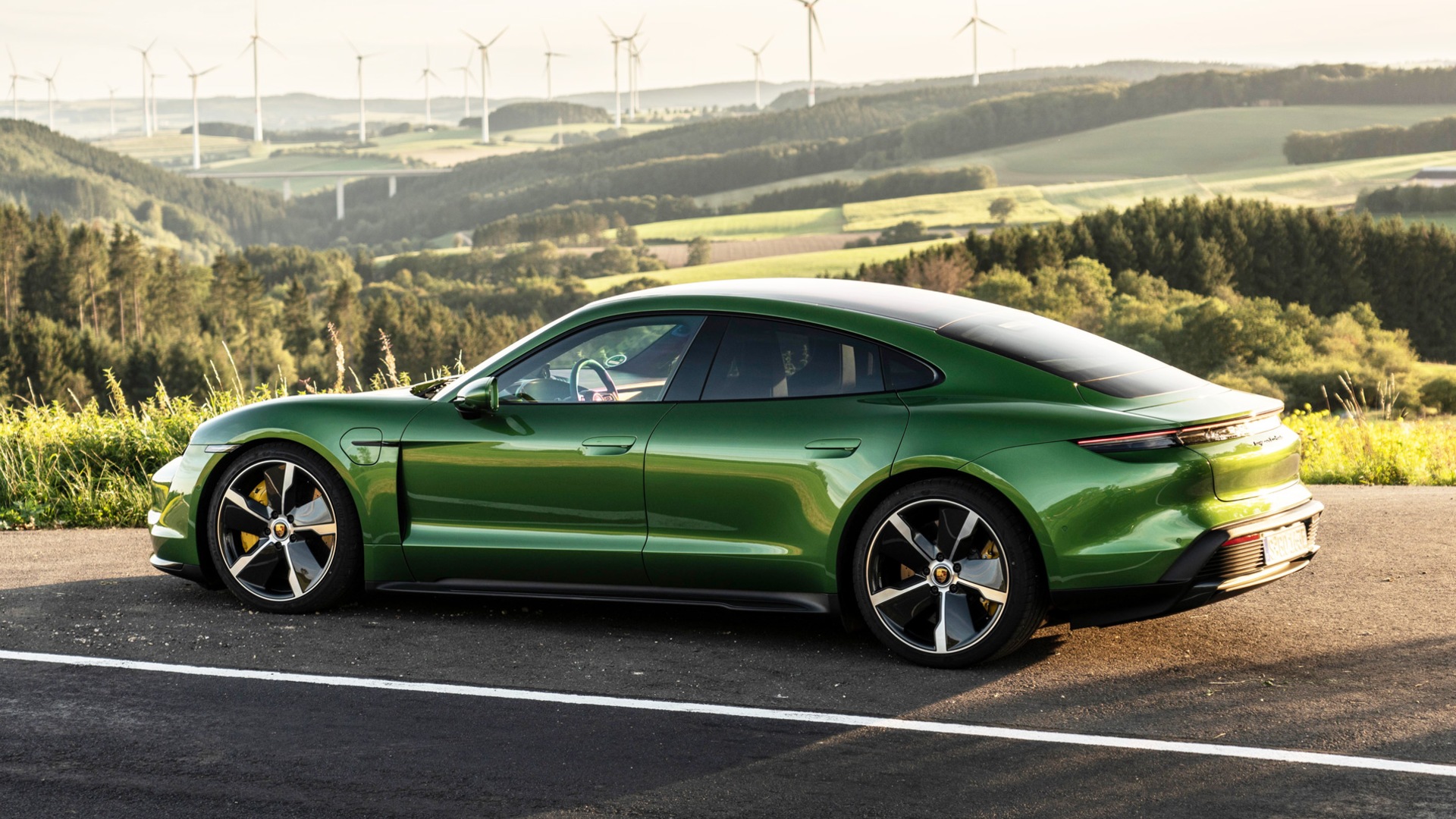Porsche’s Taycan is a stunning new EV sedan, but with a considerable price tag and a range of only 201 miles, can it stand up to Tesla’s quasi-established Model S? And why is that range so short? And why is the fast one called the “Turbo,” even though it doesn’t have any exhaust to power a charge compressor? Here’s our take on the Taycan.
The Taycan story doesn’t start with the car’s debut in September of last year. It doesn’t even start with the car’s conceptual parent, the strikingly beautiful Mission E. It starts in 2015 with Dieselgate. In September of that year, the US EPA discovered that Porsche parent company Volkswagen was lying about the emissions figures for several of their so-called “Clean Diesel” vehicles.
The ensuing scandal cost the Volkswagen Automotive Group billions in fines, recalls, and bad PR. Interestingly, the Mission E was announced at the Frankfurt Motor Show eleven days after VW admitted fault in Dieselgate. It’s unlikely that VW was holding the Mission E up its sleeve to deflect criticism about destroying the planet with smoggy diesels, but it was certainly convenient for them, and the Mission E was approved for production in December of the same year.

Whatever their motives, Porsche had the right idea with the Mission E. Its styling was bold but believable, perfectly proportioned for the near future. Somewhat resembling the Cayman (Porsche’s most attractive car currently for sale), it featured broad shoulders and daring flares filled with bill-folding 21" wheels (22" in the rear). Its party piece? Suicide doors.
Drive came to all four wheels from a pair of electric motors totaling to 600 horsepower, which could haul the heavy electro-cruiser to 60 in 3.5 seconds. At the time, Porsche claimed a total range of 310 miles, and an 80% charge, worth 250 miles, in a mere 15 minutes. By 2015 standards, this blew Tesla out of the water. Even a firehose-capacity Supercharger station could only give a Model S 205 miles in 45 minutes.
The months, and years, passed, and the Mission E began to morph into what we now know as the Taycan. Its trick suicide doors sagged into regular, front-hinged, homicide doors. Its crouched, animal curves took on that swollen, post-prime bloat that we’ve come to expect from almost every sedan.

It’s still a handsome vehicle, but the biggest disappointment for prospective buyers has been the range. The EPA recently downgraded Porsche’s updated claims of a 300 mile range to just 201 miles.
Is it an accurate number, though? Porsche hired an independent testing firm, AMCI, to challenge the EPA's claims, and found that the Taycan still got 275 miles on the highway, and 288 miles in the city, much closer to Porsche’s claims. Yet the EPA determines what dealerships have to list on the Taycan’s window sticker.
But is this really a problem? Electric car buyers aren’t exactly the demographic who skip the research when making a purchase. A few clicks will be enough to find out what the Taycan can really do for range. Yet Tesla has made enormous leaps since the Mission E’s theoretical range of 310 miles was announced four years ago. Their lineup now includes the 100D Long Range, which can go 370 miles between charges.
That’s quite the gulf. But perhaps Porsche is onto something. The Tesla has the Supercharger network, with enough Tesla-proprietary charging stations to get a Model S from sea to shining sea. Porsche seems less committed to this. The Taycan website states that their “network of efficient Porsche Turbo Chargers is steadily growing. You can charge your Taycan with up to 270 kW at these 800-volt charging stations.”
There’s also an app called Porsche Connect that has something to do with the “Porsche Charging Service.” The language surrounding this is vague, but it seems like Porsche wants the Taycan to be able to charge at any charge point around a city. As for that forecasted 15 minute charge time? It’s now 22.5 minutes, but only “under ideal conditions.”
So what’s the something that they’re onto? Porsche isn’t marketing on range right now. With this somewhat foggy plan for nationwide charging standing in contrast to Tesla’s Supercharger network, they’d rather promote the Taycan as a city car. Most daily commutes are well within that 200 (or 275) mile range, and what more do you need?
They’re also pushing the Taycan on image. It’s the Porsche allure. That legendary name, paired with the reputation of German engineering, will appeal to anyone looking for an alternative to the oversaturated Tesla or the cheaper, non-luxury Leaf and Bolt. Tesla had a record year in 2019, but they still haven’t shaken their snap-together image of panel gaps and parking lot assembly tents. With Porsche, none of this is an issue.
And while the Model S is a handsome, well-proportioned five-door, it doesn’t have the daring, flaring sports car design of the Taycan. It’s also eight years old, and newer is always better, right?
Still, the Taycan is a gamble for Porsche, especially considering the price. The base model Taycan, the 4S, costs $103,800, right about the middle of the Model S’s pricing profile, which ranges from $80,000 to $115,000. But then you start adding turbos.

If you’re confused as to why an electric car needs a turbo, you’re not alone. Porsche decided to insult everyone’s intelligence and call their faster versions of the Taycan the Turbo and Turbo S. Apparently this is some misguided throwback to the 911, whose “Turbo” moniker referenced the car’s turbocharger, a component that works by using exhaust gases to spin up an air compressor, which forces more air through the intake and into the engine, ultimately increasing power. An electric car, lacking exhaust gases, an intake, and, indeed, an engine, won’t have much use for a turbocharger. So there’s no turbo on the “Turbo.” It’s just a sticker.
The “Turbo,” which drops the 0-60 time from 3.8 seconds to just 3 flat, costs about $150,900. The Taycan Turbo S, which gets to 60 in 2.6 seconds (nearly as fast as Tesla’s fastest 2.4), is a staggering $185,000. You could get two Teslas for this price.
Porsche makes sure you’re getting your money’s worth, though. Trick features like rear-wheel steering, a three-stage automatic spoiler, adaptive air suspension, and torque vectoring promise the supercar experience.
Unlike the Tesla, there’s no mention of any autonomous features like hands-free driving. No Autopilot here. All this indicates a move beyond the simplicity of electric straight-line performance. At this point, everyone knows how fast and torquey an electric motor can be. Instead, Porsche seems to be promoting a platform of general driving excitement. They even call it a “sports car” on their website. “Okay, Tesla,” they seem to be saying, “You want to claim supercar status? Let’s see how you handle a few laps of Road America.”
Porsche knows their audience. They don’t have any lower-level electrics like the Tesla Model 3 (or perhaps, someday, the Cybertruck). Their only other electric is a hybrid, the $845,000 918 hypercar. The Taycan isn’t an attempt at an affordable electric car. It’s a more exotic, more luxurious, and higher-pedigreed alternative to the buyer who has seen enough Teslas.
 Solutions for Charging Station Gridlock | Zohr
Solutions for Charging Station Gridlock | Zohr
